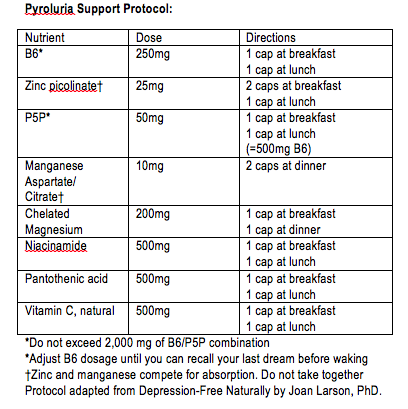Sherri Jacobs, ND, CNS
A notable patient comes through the door that has been anxious most of her life or suffered frequently from episodes of nervous exhaustion. Her anxiety has become all consuming since a major life transition. Antidepressants and antianxiety medications have not offered lasting relief. She describes herself as artistic, perfectionist and creative, but suffers from significant inner tension and fear. Since anxiety has become a common condition in our modern world, most clinicians find it a rarity when someone does not check the stress/anxiety box on their intake questionnaire; it is pervasive. As naturopathic physicians, we offer anxiety sufferers a chance at lasting relief by seeking and uncovering the underlying biochemical causes of the distress.
One biochemical cause of anxiety is a controversial and understudied condition which has significant implications in the treatment of anxiety – pyroluria. First discovered in the 1950s by Dr. Abram Hoffer, pyroluria is a genetic condition of altered hemoglobin breakdown, resulting in a depletion of vitamin B6. Without adequate B6, the body is not able to convert tryptophan to serotonin. In the absence of adequate serotonin levels, many different psychiatric disorders, like anxiety and depression can develop.
A normal by-product from the breakdown of hemoglobin, kryptopyrroles are found in elevated amounts in individuals with this genetic abnormality. As the pyrroles are being excreted from the body, they bind 2 important nutrients, vitamin B6 and zinc. The elevated levels of kryptopyrroles create a higher demand for B6 and zinc and subsequently may cause a relative deficiency. This relative deficiency results in a myriad of different symptoms that wax and wane over the years, depending on someone’s level of stress. Decompensated pyroluria is marked by symptoms of inner tension, nervous exhaustion and fearfulness.
The cumulative effects of B6 and zinc deficiencies have cascading, yet ill-defined systemic effects. Vitamin B6 is necessary for the conversion of tryptophan to the neurotransmitter serotonin, and plays important roles in proper protein and carbohydrate metabolism and a healthy immune system. Zinc regulates insulin activity, acts as a powerful antioxidant, plays a central role in immune function and regulates gene expression.
The combination of depleted B6 and zinc status is a disaster for mental health. Both nutrients are essential for healthy brain function. Dr. Joan Larson, PhD., founder of Health Recovery Center in Minneapolis and author of Depression Free Naturally explains the role of B6 and zinc in the following way: “B6 is the co-enzyme (meaning it is absolutely essential) in over fifty enzymatic brain reactions where amino groups are transformed or transferred. B6 plays an important role in your nervous system’s balance: It is required to utilize protein for energy. Brain depletion of dopamine and serotonin occur without B6, creating ongoing anxiety and depression….Zinc deficiency also results in multiple disorders. The brain uses at least sixty zinc enzymes, so zinc deficiency has a marked effect on mood states. Anxiety and depression have been observed in patients who develop zinc deficiency as a result of intravenous feedings. These patients experienced prompt relief from their acquired depression after zinc was supplied.”1
Testing
The testing is inexpensive and can be ordered directly by the patient. The lab will assess the level of pyrroles found in the urine. Results from 10-20 mcg/dL of pyrroles are considered borderline. Above 20 mcg/dL is considered positive for pyroluria.
Because of the low cost and ease of the test, I frequently recommend it after simple prescreening when I am working with a patient who complains of anxiety. A positive test encourages compliance with the protocol.
Most pyrolurics have gone undiagnosed for many years. Due to the constant anxiety creating surges of cortisol and adrenaline, it is imperative for the clinician to also treat the adrenal glands. An adrenal stress index is warranted for a complete evaluation of a pyroluric patient.
Screening
Pyroluria Screening Questionnaire
1. Do you tend to skip breakfast or have morning nausea?
2. Do you tend to be anxious?
3. Do you have other members in your immediate or extended family with schizophrenia?
4. Are there members of your immediate or extended family who have committed suicide?
5. Do you have white spots on your nails?
6. Did you get a “stitch” in your side when you ran as a child?
7. Did you have moderate to severe acne as a teenager?
8. Do you have pain or creaking in your knees?
9. Do you have cold hands and feet?
10. Do you have stretch marks as an adolescent or adult even without a large weight gain or loss?
11. Are your teeth or were your teeth before orthodontic treatment crowded with teeth growing over teeth?
12. Did puberty start a little later for you than others?
13. Are you easily tired?
14. Do you tend toward apathy?
15. Do you have a tendency toward iron-deficiency anemia or test borderline?
16. Do you have eczema or psoriasis?
17. Do you have tingling sensations or even tremors in your arms or legs?
18. Do you tend to have paler skin than other family members?
19. Do you tend to get overwhelmed in stressful situations?
20. Do you have trouble remembering your dreams?
21. Are you now or have you been a vegetarian?
22. Are you now or have you before been an alcoholic?
23. Do you find yourself socially withdrawn and dependent fairly strongly on one person?
24. Do you have poor short-term memory?
25. Poor ability to cope with stress?
26. Mood swings or temper outbursts?
27. Much higher capability and alertness in the evening compared to mornings?
28. Sensitive to bright light?
Supportive Treatment

Response to Treatment
Individuals with pyroluria, loosely called pyrolurics, will notice marked benefit with the protocol in about 6 weeks. Although, most people, especially with long-standing anxiety, will require 6 months of treatment, my pyroluric patients have been able to discontinue their protocol after 3-4 months and then use the supplements on an “as needed” basis. Since pyroluria is a genetic condition, supplementation will be required for a lifetime; however, most patients are able to take supplement breaks. The pyroluric patient will notice the familiar inner tension as a sign to return to the protocol.
Conclusion
As a clinician who specializes in the nutritional management of stress, I can say that pyroluria is NOT the most common nutritional cause of anxiety. It is a cause that is worthy of attention, however. Admittedly, there is a dearth of adequate research and scientific articles on the topic. However, my clinical experience has proven it worth consideration. The level of anxiety and inner tension experienced by a pyroluric is considerable. The benefits of diagnosing and treating pyroluria are life changing. I encourage each of you to add it to your differential diagnosis when assessing a patient with a history of anxiety.
Case Study
Claire
27-year-old female
No significant past medical history
Chief complaint: Anxiety
Claire was fair-skinned, freckled and thin. She described herself as always uptight, perfectionist, unable to relax, mild insomnia, easily startled, worrier. She remembers being this way most of her life, although her anxiety seems to be getting worse over the past few years. She describes her mother as highly anxious and over protective, although her mother has denied any anxiety issues. Her twin sister has similar issues with anxiety.
Patient was seeing a counselor and had tried numerous antidepressant and antianxiety medications without lasting relief.
PE: numerous white spots on nails, cold extremities, otherwise unremarkable
Labs: Mild anemia (borderline low Hgb and Hct, decreased MCV, elevated RDW, ferritin at 11ng/mL, otherwise unremarkable)
Recommendations: While waiting for the results of her pyroluria test, I placed her on a diet focused on stabilizing blood sugar levels. I gave her specific recommendations for decreasing stress (regular exercise, breathing techniques).
Pyroluria test: Positive at 25mcg/dL
Patient started the complete pyroluria protocol. At her 2 week follow-up, she noticed mild improvement in sleep. I did not hear from the patient again for 5 months. After 5 months she sent me an email update. She was feeling so much better after 3 months on the protocol that she decided to make a change. She moved across the country and started a new job. Her stress levels were manageable and she felt stronger than she could remember. She was also training for a marathon. Her focus was now on convincing her sister to take a pyroluria test.
 Sherri Jacobs, ND, CNS graduated from Bastyr University in 2005. Her practice is centered on nutrition therapy for women’s health, weight loss and stress management. She is co-creator of the 360 Weight Loss Plan. You can find more information about Dr. Jacobs and her practice at www.HealthECoaching.com.
Sherri Jacobs, ND, CNS graduated from Bastyr University in 2005. Her practice is centered on nutrition therapy for women’s health, weight loss and stress management. She is co-creator of the 360 Weight Loss Plan. You can find more information about Dr. Jacobs and her practice at www.HealthECoaching.com.
References
1. Larson J. Depression-Free Naturally: 7 Weeks to Eliminating Anxiety, Despair, Fatigue, and Anger from Your Life. New York, NY: Random House Publishing Group; 1999.
2. Kaslow J. Pyroluria. drkaslow.com Web site. http://www.drkaslow.com/html/pyroluria.html. Accessed January 25, 2010.